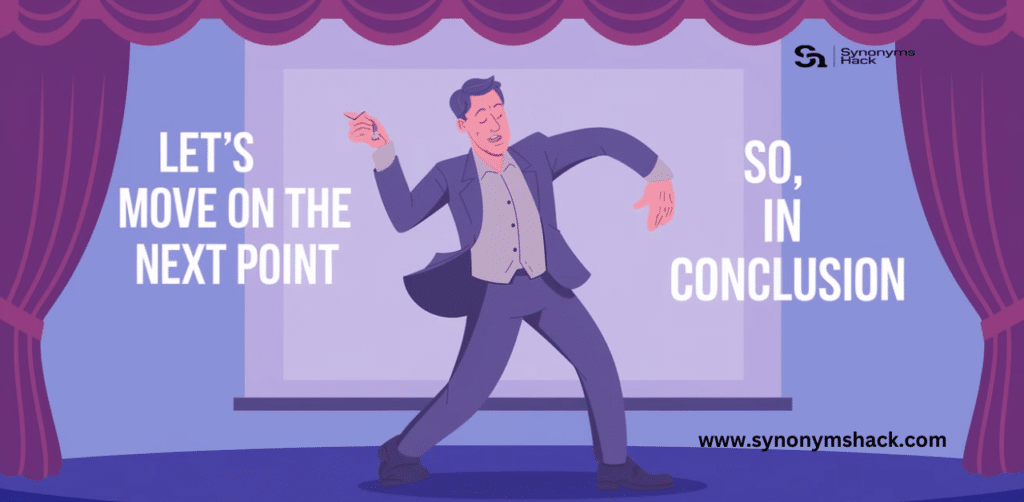Ever felt like your writing’s stuck in a rut? You’re not alone. We’ve all been there, reaching for those tired old standbys: firstly, secondly, thirdly. But what if I told you there’s a whole world of transitional phrases waiting to spice up your prose?
Imagine transforming your bland list into a captivating journey through your ideas. Picture your readers hanging on every word, eager to see where you’ll lead them next. That’s the power of mixing up your transitional phrases and finding alternative ways to express sequence.
Read Also: 20 Creative Ways to Say “Save the Date” (With Examples)
is it professionally okay to say the “firstly, secondly, thirdly”?
Absolutely! In fact, varying your language can make your writing more engaging and showcase your communication skills. Professional writing isn’t about sticking to a rigid formula; it’s about clarity, flow, and keeping your audience hooked.

Fresh List of Alternatives to “Firstly, Secondly, Thirdly”
Here’s a complete list of all 20 alternative ways to structure your arguments and express sequence:
- To Begin With, Furthermore, Lastly
- One, Another, Finally
- First and Foremost, Moreover, Above All
- For Starters, Also, To Top It Off
- Initially, Subsequently, Ultimately
- Primarily, Additionally, Crucially
- To Start, In Addition, In Conclusion
- Let’s Begin With, Moving On To, To Wrap Up
- For One Thing, What’s More, Most Importantly
- Consider This, Better Yet, Here’s the Kicker
- At the Outset, Next Up, In the End
- Get This, But Wait There’s More, The Best Part
- In the First Instance, Furthermore, In Conclusion
- Let’s Kick Things Off, Moving Right Along, To Wrap Things Up
- For Starters, But That’s Not All, The Clincher Is
- To Begin, Building On That, To Culminate
- Picture This, Now Consider, Here’s the Twist
- At the Onset, As We Progress, In Due Course
- Above All Else, Equally Important, Last But Not Least
- For One, Not to Mention, As a Final Point
You should read: Other Ways To Say “Thinking Of You”
1. To Begin With, Furthermore, Lastly
This trio offers a subtle shift from the standard “firstly, secondly, thirdly” while maintaining a clear logical progression. It’s perfect for when you want to sound a tad more sophisticated without straying too far from familiar territory.
Example: Planning a Company Retreat
Sarah, the HR manager, sent out an email outlining the upcoming retreat:
“Team,
I’m thrilled to share our plans for this year’s company retreat. To begin with, we’ve chosen a stunning lakeside resort that’ll provide the perfect backdrop for our activities. Furthermore, we’ve lined up some exciting team-building exercises, including a scavenger hunt and cooking challenge. Lastly, we’ve scheduled free time for you to enjoy the resort’s amenities and bond with colleagues.
Get ready for an unforgettable experience!”
2. One, Another, Finally
This approach adds variety in expression while keeping things clear and concise. It’s great for when you want to enhance writing without sounding too formal.
Example: Discussing Project Benefits
In a team meeting, project manager Alex explains:
“Let’s talk about why this new software is a game-changer. One, it’ll cut our processing time in half. Another huge benefit is the improved data security features. Finally, the user-friendly interface will make training a breeze.”
3. First and Foremost, Moreover, Above All

This set of phrases helps you improve writing by adding emphasis and building to a climax. It’s perfect for when you want to drive home the importance of your points.
Example: Customer Service Policy Update
A memo from the Customer Service Director, Emily:
“Team,
We’re updating our customer service policies, and I want to highlight the key changes:
First and foremost, we’re extending our response time guarantee to 24 hours. Moreover, we’re introducing a new customer feedback system to better track satisfaction. Above all, remember that our goal is to exceed expectations in every interaction.”
4. For Starters, Also, To Top It Off
Want to keep things light and conversational? This set of phrases helps you structure arguments in a more relaxed tone, perfect for informal communications or creative writing.
Example: Promoting a New Product
Marketing exec Tom drafts an email to the sales team:
“Hey gang,
Get pumped about our new eco-friendly water bottle line! For starters, they’re made from 100% recycled materials. Also, they come in ten awesome colors. To top it off, for every bottle sold, we’re donating a dollar to ocean cleanup efforts.
Time to make waves in the market!”
Don’t miss it: Other Ways To Say “First Come First Serve”
5. Initially, Subsequently, Ultimately
These terms add a sense of progression and time to your points, helping to enhance writing with a subtle narrative flow.
Example: Project Timeline Overview
Project coordinator Lisa outlines the phases in a client email:
“Dear Mr. Johnson,
Here’s a brief overview of our project timeline:
Initially, we’ll conduct a thorough analysis of your current systems. Subsequently, we’ll develop and test the new software. Ultimately, we’ll roll out the implementation and provide comprehensive staff training.
We’re excited to begin this journey with your company.”
6. Primarily, Additionally, Crucially

This set helps you organize points while subtly indicating their relative importance, adding depth to your argument structure.
Example: New Policy Introduction
HR Director Mark sends out a company-wide email:
“All employees,
We’re implementing changes to our remote work policy:
Primarily, all employees will now have the option to work from home two days a week. Additionally, we’re providing a stipend for home office equipment. Crucially, these changes aim to improve work-life balance without compromising productivity.
Your team leads will provide more details soon.”
7. To Start, In Addition, In Conclusion
These phrases clearly signal the logical progression of your ideas, perfect for essays, reports, or any writing where you need to guide your reader through your thought process.
Example: Analyzing Market Trends
Market analyst Jenna presents her findings:
“To start, our data shows a 15% increase in demand for sustainable products. In addition, we’re seeing a shift towards online shopping across all age groups. In conclusion, these trends suggest we should focus on developing our eco-friendly product line and enhancing our e-commerce platform.”
Also read: Other Ways To Say “Keep Up The Good Work”
8. Let’s Begin With, Moving On To, To Wrap Up
This set of phrases adds a sense of action and movement to your writing, great for presentations or when you want to energize your audience.
Example: Team Meeting Agenda
Team leader Ryan kicks off the weekly meeting:
“Alright team, let’s dive in. Let’s begin with a quick rundown of last week’s wins. Moving on to our challenges, I want to brainstorm solutions for our supply chain hiccup. To wrap up, we’ll go over next week’s targets and action items.
Ready to rock this meeting?”
9. For One Thing, What’s More, Most Importantly

These phrases help you enhance writing by shifting focus and emphasis, allowing you to highlight different aspects of your argument.
Example: Product Feature Highlight
Product manager Olivia emails the marketing team:
“Hey creative minds,
Let’s spotlight our new smartphone’s killer features:
For one thing, it’s got an unbeatable 72-hour battery life. What’s more, the camera quality is off the charts with its new AI enhancement. Most importantly, we’ve managed to keep the price point competitive.
Time to make some noise about this game-changer!”
10. Consider This, Better Yet, Here’s the Kicker
Want to keep your readers on their toes? This set of phrases adds an element of surprise and intrigue to your writing, perfect for enhancing writing that needs to captivate and engage.
Example: Sales Pitch Email
Sales rep Jake crafts an enticing pitch:
“Dear Ms. Thompson,
I’ve got a proposition that’ll revolutionize your business. Consider this: our software can cut your data processing time in half. Better yet, it integrates seamlessly with your existing systems. Here’s the kicker: we’re offering a 30-day free trial with no strings attached.
11. At the Outset, Next Up, In the End
This set of phrases helps readers follow your logical progression while giving a sense of movement through your points.
Example: Project Status Update
Project manager Zoe sends an email to stakeholders:
“Dear Team,
Here’s where we stand on Project Phoenix:
At the outset, we’ve completed the initial research phase ahead of schedule. Next up, we’re diving into prototype development. In the end, we’ll conduct extensive user testing before launch.
We’re making great strides!”
You must read: Other Ways To Say” The Text State”
12. Get This, But Wait There’s More, The Best Part
These phrases inject excitement into your writing, perfect for improving writing in marketing or persuasive contexts.
Example: New Product Launch
Marketing director Chris drafts a company-wide announcement:
“Team,
Our new smartwatch is ready to take the market by storm! Get this: it has a battery life of two weeks. But wait, there’s more – it’s completely waterproof up to 100 meters. The best part? It’s priced lower than our competitors.
Prepare for a game-changing launch!”
13. In the First Instance, Furthermore, In Conclusion
When you need to structure arguments in a more formal tone, this set of phrases adds a touch of sophistication to your writing clarity.
Example: Academic Paper Introduction
Professor Williams begins her research paper:
“This study examines the effects of social media on adolescent mental health. In the first instance, we’ll review existing literature on the topic. Furthermore, we’ll present our methodology and findings. In conclusion, we’ll discuss the implications for future research and policy.”
14. Let’s Kick Things Off, Moving Right Along, To Wrap Things Up

These phrases create a conversational tone, ideal for enhancing writing in presentations or informal reports.
Example: Team Building Workshop
HR specialist Tom introduces the day’s activities:
“Welcome, everyone! Let’s kick things off with a quick icebreaker game. Moving right along, we’ll dive into some problem-solving exercises. To wrap things up, we’ll reflect on what we’ve learned and how to apply it back at the office.
Ready for a fun and productive day?”
15. For Starters, But That’s Not All, The Clincher Is
This set helps build excitement and anticipation throughout your writing, great for improving writing in sales or promotional contexts.
Example: Event Promotion Email
Event planner Maria teases an upcoming conference:
“Dear Attendees,
Get ready for TechCon 2025! For starters, we’ve secured keynote speeches from industry leaders. But that’s not all – we’re offering hands-on workshops with cutting-edge tech. The clincher is our exclusive networking event with top investors.
Don’t miss this career-defining opportunity!”
16. To Begin, Building On That, To Culminate
These phrases help you organize points in a way that shows how each idea builds upon the last, perfect for argument structure in essays or reports.
Example: Business Proposal
Consultant Alex outlines a strategy for a client:
“To begin, we’ll conduct a comprehensive market analysis. Building on that, we’ll develop a tailored marketing strategy for your product. To culminate, we’ll implement and monitor the campaign, adjusting as needed for optimal results.”
17. Picture This, Now Consider, Here’s the Twist
This set of phrases engages the reader’s imagination and keeps them guessing, excellent for enhancing writing in creative or narrative contexts.
Example: Short Story Opening
Aspiring novelist Jess starts her tale:
“Picture this: a quiet suburban street at midnight. Now consider a strange blue glow emanating from every house. Here’s the twist: the residents have no idea anything’s amiss.
Welcome to Luminous Lane, where nothing is as it seems.”
18. At the Onset, As We Progress, In Due Course
These phrases add a temporal element to your writing, helping readers follow the logical progression of events or ideas.
Don’t miss it: Ways to Improve Your Communication Skills
Example: Long-Term Business Plan
CEO Sarah outlines the company’s future:
“At the onset, we’ll focus on expanding our domestic market share. As we progress, we’ll explore international opportunities in emerging markets. In due course, we aim to become the global leader in sustainable technology solutions.”
19. Above All Else, Equally Important, Last But Not Least
This set helps you structure arguments while emphasizing the importance of each point, useful for persuasive writing or when all points carry significant weight.
Example: Company Values Statement
Founder Mike articulates the company’s core principles:
“Above all else, we value integrity in all our business dealings. Equally important is our commitment to innovation and pushing boundaries. Last but not least, we prioritize our employees’ well-being and professional growth.”
20. For One, Not to Mention, As a Final Point
These phrases offer a smooth transition between ideas, helping to improve writing flow and maintain reader engagement.
Example: Product Review
Tech blogger Lisa reviews the latest smartphone:
“The NewTech Pro impresses on multiple fronts. For one, its camera quality is unparalleled in this price range. Not to mention, the battery life easily lasts two full days. As a final point, the sleek design makes it a standout in the crowded smartphone market.”
By incorporating these additional alternatives to firstly secondly thirdly, you’ll further enhance your writing clarity and keep your audience captivated. Remember, the key to effective writing is not just what you say, but how you say it. These transitional phrases are powerful tools in your writing arsenal.
For more tips on improving writing and mastering transitional phrases, check out the Purdue Online Writing Lab, an excellent resource for writers of all levels.
With these 20 alternatives at your disposal, you’re well-equipped to create engaging, varied, and impactful content. Happy writing!

Wrapping It Up: these alternatives to “firstly secondly thirdly“
There you have it – twenty dynamic ways to breathe new life into your writing. By swapping out the tired “firstly, secondly, thirdly” for these alternative ways to express sequence, you’ll instantly boost your writing clarity and keep your readers engaged.
Remember, great writing is about more than just getting your point across. It’s about creating a journey for your reader, guiding them through your ideas with style and finesse. These transitional phrases are your secret weapons in that quest..
So go ahead, mix it up! Experiment with these alternatives to firstly secondly thirdly and watch your writing transform. Your readers will thank you, and you might just find yourself falling in love with the writing process all over again.
After all, in the grand tapestry of language, why settle for just three threads when you’ve got a whole rainbow at your fingertips?

Brad Hook is the insightful admin and writer who brings depth and clarity to the world of synonyms. With a talent for making words accessible and engaging, he inspires readers to expand their vocabulary and explore language’s nuances. Brad’s writing helps others communicate more effectively and creatively every day.








